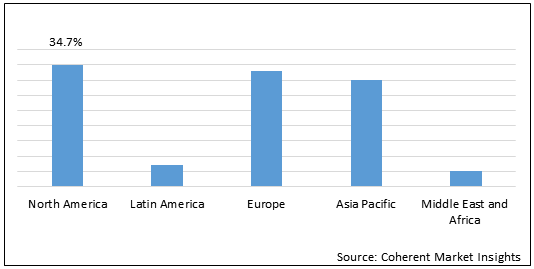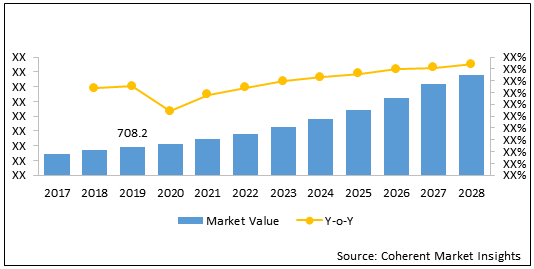Space Planning Software Market helps to plan a particular space on computing devices which helps in reducing costs and utilizing the whole area properly without leaving any space place. Furthermore, the global space planning software platform market is segmented on basis of component, solution, deployment model, end-user, and region.
Increasing cloud-based application deployments is expected to drive growth of the global space planning software market during the forecast period. Currently, companies are shifting from complex on-premises deployment to cloud-based (SaaS-based) deployment owing to its low total cost of ownership (TCO) and on-demand access. The cloud-based space planning software (SaaS) offers features such as better reliability and lower costs. Moreover, workplace management and optimization software provider companies are offering their cloud-based solutions that can be integrated with companies’ existing cloud-based space planning software. For instance, in March 2017, Serraview, a provider of workplace management and optimization software, entered into partnership with PointGrab, a developer of the CogniPoint edge-analytics smart sensing solution. By integrating CogniPoint with Serraview’s cloud-based space planning software, it will help organizations to transform their workstations by delivering real-time space utilization intelligence, which results in increased employee productivity and less wasted space. Therefore, these factors are expected to propel the global space planning software market growth over the forecast period (2021-2028).
Global Space Planning Software Market - Impact of Coronavirus (Covid-19) Pandemic
COVID-19 has significantly disrupted almost all the industries including transportation, manufacturing, oil and gas, infrastructure, and others. To combat COVID-19 pandemic, most of the countries had implemented lockdown and are now easing it phase-wise and industry wise. Therefore, the space planning software market growth has temporarily slowed down.
COVID-19 pandemic has augmented trends in office space planning. Work from home policies were already impacting the modern workspace before the COVID-19 pandemic. At present, most of the companies are willing to bring their workforces back into safe and sustainable work patterns. For instance, in June 2020, iOFFICE, a provider of cloud-based integrated workplace management and facilities management solutions, introduced a new feature called Space-Right, in space management software. The new space-right feature enables companies to update floor plans and implement safe distancing in their workspaces.
North America is expected to hold dominant position in the global space planning software market during the forecast period.
Statistics:
North America held dominant position in the global space planning software market in 2019, accounting for 34.7% share in terms of value, followed by Europe and Asia Pacific.
Space Planning Software Market Report Coverage
| Report Coverage | Details | ||
|---|---|---|---|
| Base Year: | 2019 | Market Size in 2019: | USD 708.2 Mn |
| Historical Data for: | 2017 to 2020 | Forecast Period: | 2020 to 2027 |
| Forecast Period 2021 to 2028 CAGR: | 8.11% | 2028 Value Projection: | USD 1,393.7 Mn |
| Geographies covered: |
|
||
| Segments covered: |
|
||
| Companies covered: |
Accruent, Archibus, FM:Systems Group, LLC, IBM TRIRIGA, iOFFICE, OfficeSpace Software, Planon, QuickFMS, and SPACEWELL INTERNATIONAL |
||
| Growth Drivers: |
|
||
| Restraints & Challenges: |
|
||
Uncover macros and micros vetted on 75+ parameters: Get instant access to report
Figure 1: Global Space Planning Software Market Share (%) in terms of Value, By Region, 2019
To learn more about this report, Download Free Sample
North America is expected to be dominant in the global space planning software market, owing to the presence of well-established companies in the region. Some of the players include IBM Corporation (TRIRIGA), Accruent, OfficeSpace Software, and FM:Systems. The increasing demand for space planning software from healthcare and education industries in the North America region is also expected to positively impact the growth of global space planning software market. For instance, in January 2018, FM:Systems, a provider of space management technology, entered into partnership with Zenit, a Building Information Modeling (BIM) software and consulting services firm. The objective of the partnership was to improve space utilization and space allocation in healthcare and education industry. Also, this partnership helped FM:Systems to enhance its presence in Quebec, Canada.
Among type end-user segment, the healthcare segment is expected to dominate the market during the forecast period. The growth of the segment is driven by adoption of space planning software.
The rising number of patients have forced hospital and healthcare systems to use space planning software in order to identify the maximum number of beds that can be made available, especially during (and after) the COVID-19 crisis. Therefore, these factors are expected to create huge opportunity for the global space planning software market growth over the forecast period.
Figure 2: Global Space Planning Software Market Share Value (US$ Mn), 2017-2028

To learn more about this report, Download Free Sample
The global Space Planning Software market was valued at US$ 708.2 Mn in 2019 and is expected to reach US$ 1,393.6 Mn by 2028 at a CAGR of 8.11% between 2021 and 2028.
Share
Share
Missing comfort of reading report in your local language? Find your preferred language :
Transform your Strategy with Exclusive Trending Reports :
Frequently Asked Questions
Select a License Type
Joining thousands of companies around the world committed to making the Excellent Business Solutions.
View All Our Clients